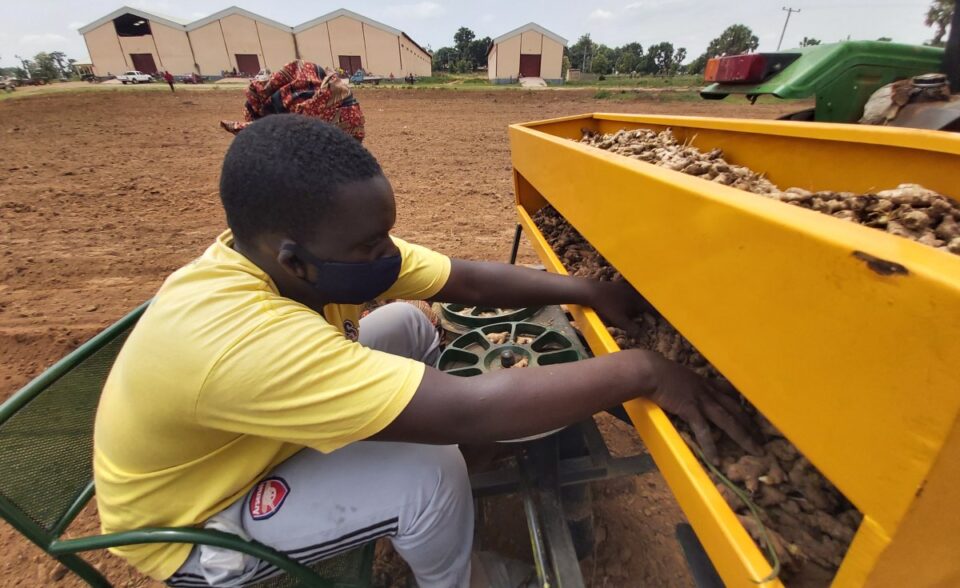Planting and harvesting machinery play a crucial role in modern agricultural practices, revolutionizing traditional farming methods and enhancing efficiency, productivity, and sustainability. In ginger operations, specialized machinery tailored to the unique requirements of ginger cultivation has emerged, offering farmers innovative solutions to streamline planting and harvesting processes.
As the ginger industry continues to evolve, technological advancements will remain instrumental in meeting the growing demand for high-quality ginger products while ensuring sustainability and profitability for farmers. By embracing innovative machinery solutions and leveraging cutting-edge technologies, ginger growers can unlock new opportunities for growth and success in an increasingly competitive agricultural landscape.
Planting Machinery:
Efficient and precise planting machinery is essential for establishing uniform crop stands, optimizing space utilization, and maximizing yield potential in ginger cultivation. Key innovations in planting machinery for ginger operations include:
a. Precision Seeders: Precision seeders equipped with adjustable seeding mechanisms and spacing
controls ensure accurate placement of ginger rhizomes at predetermined intervals. These seeders facilitate uniform distribution of rhizomes across the planting bed, minimizing wastage and maximizing planting density for optimal yield.
b. Mulch Layers and Plastic Mulch Installers: Mulch layers and plastic mulch installers automate the process of laying mulch films or plastic covers over ginger beds, providing weed suppression, moisture retention, and soil temperature regulation benefits. These machines reduce labor requirements and ensure consistent mulch application, enhancing weed control and moisture management during the early stages of ginger growth.
c. Bed Formers and Ridge Planters: Bed formers and ridge planters are specialized implements designed to create raised planting beds or ridges suitable for ginger cultivation. These machines shape the soil into elevated rows, facilitating proper drainage, aeration, and root development while minimizing waterlogging and soil compaction issues commonly associated with flat planting surfaces.
Harvesting Machinery:
Efficient harvesting machinery is essential for timely and cost-effective harvesting of ginger rhizomes, ensuring minimal damage and maximizing post-harvest quality. Innovations in harvesting machinery for ginger operations include:
a. Mechanical Harvesters: Mechanical harvesters equipped with digging blades or conveyor belts are employed for the mechanical extraction of ginger rhizomes from the soil. These harvesters streamline the harvesting process, significantly reducing labor requirements and harvesting time while minimizing damage to the rhizomes.
b. Top Lifters and Windrowers: Top lifters and windrowers are specialized machines designed to lift and gather ginger plants from the field into neat windrows or rows for subsequent harvesting. These machines facilitate the efficient collection and handling of ginger plants, preparing them for further processing or storage.
c. Cleaning and Sorting Equipment: Cleaning and sorting equipment such as destoners, washers, and grading machines are utilized to remove soil, debris, and undersized rhizomes from harvested ginger, ensuring product quality and uniformity. These machines automate the post-harvest processing tasks, improving efficiency and consistency in ginger handling operations.
Integrated Systems and Automation:
Integration of planting and harvesting machinery with advanced technologies such as GPS (Global Positioning System), sensors, and automation systems further enhances their capabilities and performance in ginger operations. Key features of integrated systems and automation include:
a. GPS Guidance and Mapping: GPS-guided planting and harvesting machinery enable precise positioning and navigation within the field, ensuring accurate implementation of planting and harvesting operations. Real-time mapping capabilities provide farmers with valuable insights into field conditions, allowing for data-driven decision-making and optimization of farm management practices.
b. Sensor-Based Monitoring and Control: Sensor-based monitoring systems integrated into planting and harvesting machinery allow for real-time monitoring of critical parameters such as soil moisture, temperature, and crop health. These sensors provide feedback to automated control systems, enabling adjustments to planting depth, row spacing, harvesting speed, and other variables to optimize performance and resource utilization.
c. Robotics and AI (Artificial Intelligence): Robotics and AI technologies are increasingly being incorporated into planting and harvesting machinery to automate repetitive tasks, improve precision, and enhance efficiency. Autonomous robotic platforms equipped with AI algorithms can identify and selectively harvest ripe ginger rhizomes while avoiding damage to surrounding plants or soil.
Innovations in planting and harvesting machinery have transformed ginger operations, offering farmers unprecedented levels of efficiency, precision, and productivity, while offering a vital role in optimizing every stage of the ginger cultivation cycle. Integrated systems and automation further enhance the capabilities of planting and harvesting machinery, enabling data-driven decision-making and adaptive management practices.

